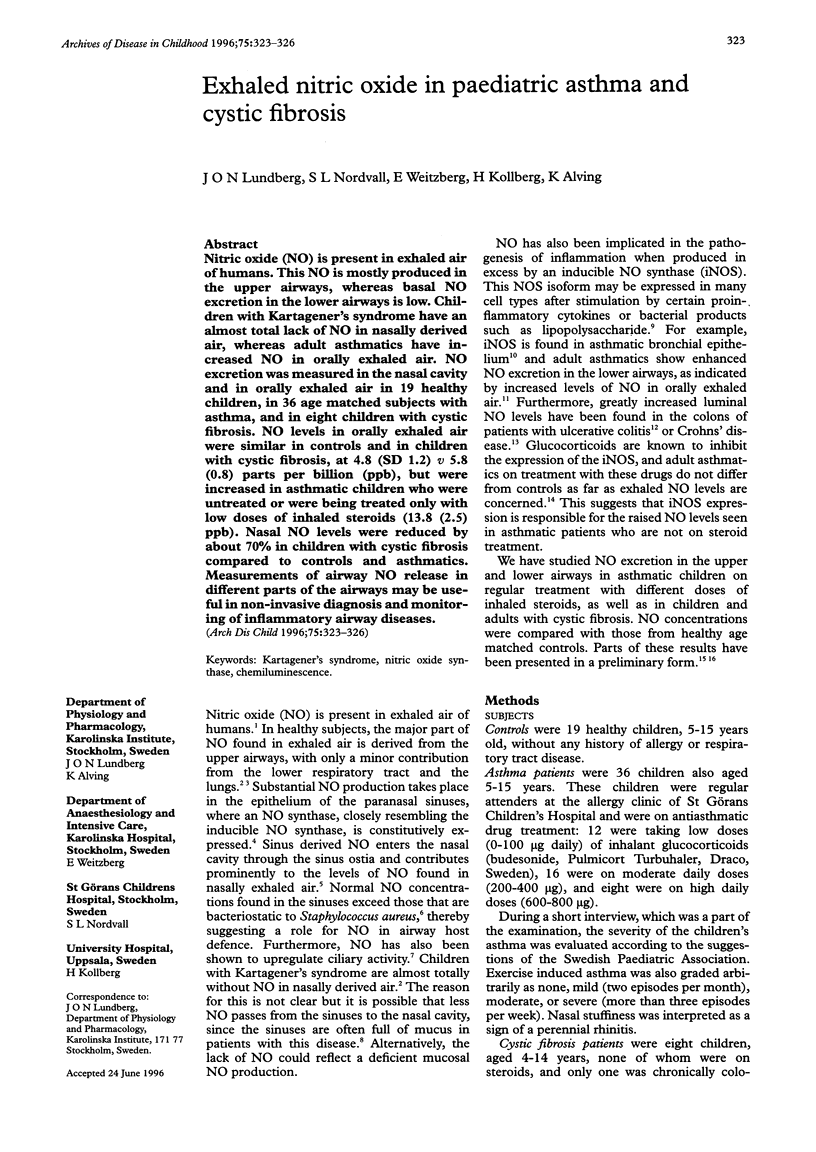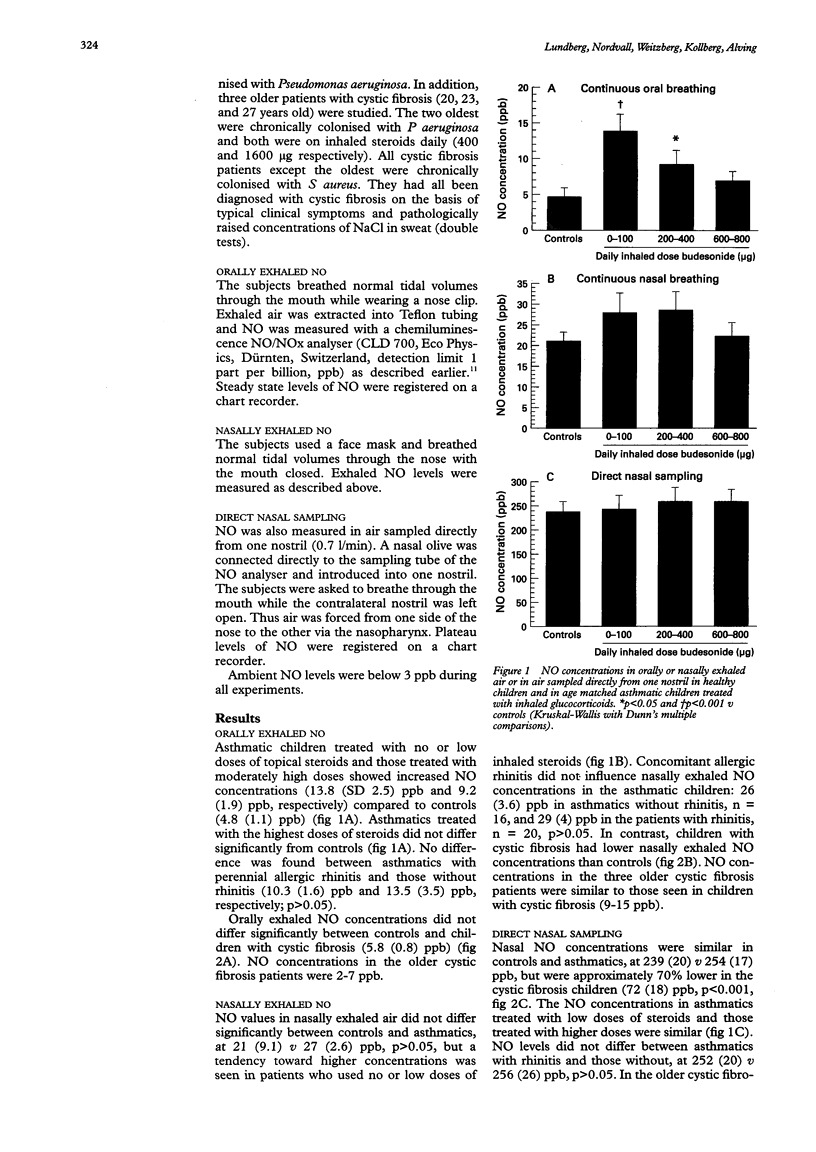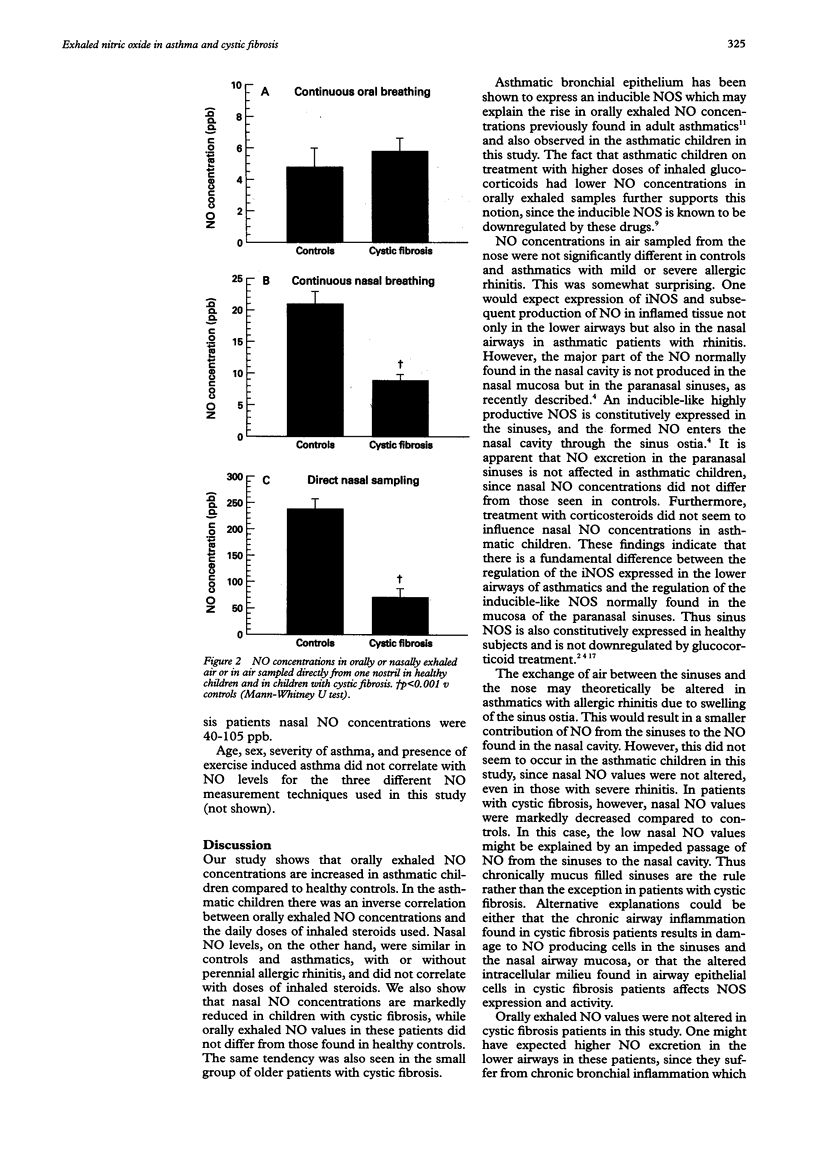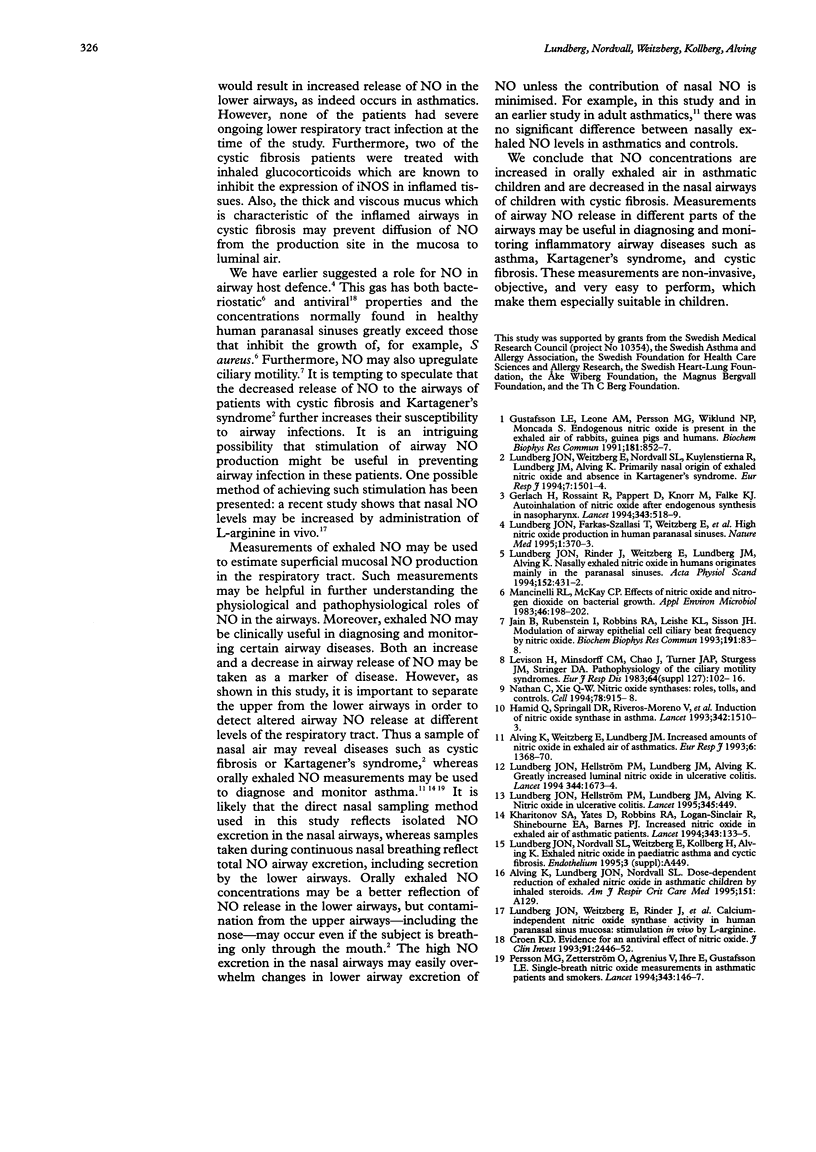Abstract
Nitric oxide (NO) is present in exhaled air of humans. This NO is mostly produced in the upper airways, whereas basal NO excretion in the lower airways is low. Children with Kartagener's syndrome have an almost total lack of NO in nasally derived air, whereas adult asthmatics have increased NO in orally exhaled air. NO excretion was measured in the nasal cavity and in orally exhaled air in 19 healthy children, in 36 age matched subjects with asthma, and in eight children with cystic fibrosis. NO levels in orally exhaled air were similar in controls and in children with cystic fibrosis, at 4.8 (SD 1.2) v 5.8 (0.8) parts per billion (ppb), but were increased in asthmatic children who were untreated or were being treated only with low doses of inhaled steroids (13.8 (2.5) ppb). Nasal NO levels were reduced by about 70% in children with cystic fibrosis compared to controls and asthmatics. Measurements of airway NO release in different parts of the airways may be useful in non-invasive diagnosis and monitoring of inflammatory airway diseases.
Full text
PDF



Selected References
These references are in PubMed. This may not be the complete list of references from this article.
- Alving K., Weitzberg E., Lundberg J. M. Increased amount of nitric oxide in exhaled air of asthmatics. Eur Respir J. 1993 Oct;6(9):1368–1370. [PubMed] [Google Scholar]
- Croen K. D. Evidence for antiviral effect of nitric oxide. Inhibition of herpes simplex virus type 1 replication. J Clin Invest. 1993 Jun;91(6):2446–2452. doi: 10.1172/JCI116479. [DOI] [PMC free article] [PubMed] [Google Scholar]
- Gerlach H., Rossaint R., Pappert D., Knorr M., Falke K. J. Autoinhalation of nitric oxide after endogenous synthesis in nasopharynx. Lancet. 1994 Feb 26;343(8896):518–519. doi: 10.1016/s0140-6736(94)91465-6. [DOI] [PubMed] [Google Scholar]
- Gustafsson L. E., Leone A. M., Persson M. G., Wiklund N. P., Moncada S. Endogenous nitric oxide is present in the exhaled air of rabbits, guinea pigs and humans. Biochem Biophys Res Commun. 1991 Dec 16;181(2):852–857. doi: 10.1016/0006-291x(91)91268-h. [DOI] [PubMed] [Google Scholar]
- Hamid Q., Springall D. R., Riveros-Moreno V., Chanez P., Howarth P., Redington A., Bousquet J., Godard P., Holgate S., Polak J. M. Induction of nitric oxide synthase in asthma. Lancet. 1993 Dec 18;342(8886-8887):1510–1513. doi: 10.1016/s0140-6736(05)80083-2. [DOI] [PubMed] [Google Scholar]
- Jain B., Rubinstein I., Robbins R. A., Leise K. L., Sisson J. H. Modulation of airway epithelial cell ciliary beat frequency by nitric oxide. Biochem Biophys Res Commun. 1993 Feb 26;191(1):83–88. doi: 10.1006/bbrc.1993.1187. [DOI] [PubMed] [Google Scholar]
- Kharitonov S. A., Yates D., Robbins R. A., Logan-Sinclair R., Shinebourne E. A., Barnes P. J. Increased nitric oxide in exhaled air of asthmatic patients. Lancet. 1994 Jan 15;343(8890):133–135. doi: 10.1016/s0140-6736(94)90931-8. [DOI] [PubMed] [Google Scholar]
- Levison H., Mindorff C. M., Chao J., Turner J. A., Sturgess J. M., Stringer D. A. Pathophysiology of the ciliary motility syndromes. Eur J Respir Dis Suppl. 1983;127:102–117. [PubMed] [Google Scholar]
- Lorenz R., Born P., Olbert P., Classen M. Factor XIII substitution in ulcerative colitis. Lancet. 1995 Feb 18;345(8947):449–450. doi: 10.1016/s0140-6736(95)90428-x. [DOI] [PubMed] [Google Scholar]
- Lundberg J. O., Farkas-Szallasi T., Weitzberg E., Rinder J., Lidholm J., Anggåard A., Hökfelt T., Lundberg J. M., Alving K. High nitric oxide production in human paranasal sinuses. Nat Med. 1995 Apr;1(4):370–373. doi: 10.1038/nm0495-370. [DOI] [PubMed] [Google Scholar]
- Lundberg J. O., Hellström P. M., Lundberg J. M., Alving K. Greatly increased luminal nitric oxide in ulcerative colitis. Lancet. 1994 Dec 17;344(8938):1673–1674. doi: 10.1016/s0140-6736(94)90460-x. [DOI] [PubMed] [Google Scholar]
- Lundberg J. O., Rinder J., Weitzberg E., Lundberg J. M., Alving K. Nasally exhaled nitric oxide in humans originates mainly in the paranasal sinuses. Acta Physiol Scand. 1994 Dec;152(4):431–432. doi: 10.1111/j.1748-1716.1994.tb09826.x. [DOI] [PubMed] [Google Scholar]
- Lundberg J. O., Weitzberg E., Nordvall S. L., Kuylenstierna R., Lundberg J. M., Alving K. Primarily nasal origin of exhaled nitric oxide and absence in Kartagener's syndrome. Eur Respir J. 1994 Aug;7(8):1501–1504. doi: 10.1183/09031936.94.07081501. [DOI] [PubMed] [Google Scholar]
- Mancinelli R. L., McKay C. P. Effects of nitric oxide and nitrogen dioxide on bacterial growth. Appl Environ Microbiol. 1983 Jul;46(1):198–202. doi: 10.1128/aem.46.1.198-202.1983. [DOI] [PMC free article] [PubMed] [Google Scholar]
- Nathan C., Xie Q. W. Nitric oxide synthases: roles, tolls, and controls. Cell. 1994 Sep 23;78(6):915–918. doi: 10.1016/0092-8674(94)90266-6. [DOI] [PubMed] [Google Scholar]
- Persson M. G., Zetterström O., Agrenius V., Ihre E., Gustafsson L. E. Single-breath nitric oxide measurements in asthmatic patients and smokers. Lancet. 1994 Jan 15;343(8890):146–147. doi: 10.1016/s0140-6736(94)90935-0. [DOI] [PubMed] [Google Scholar]


